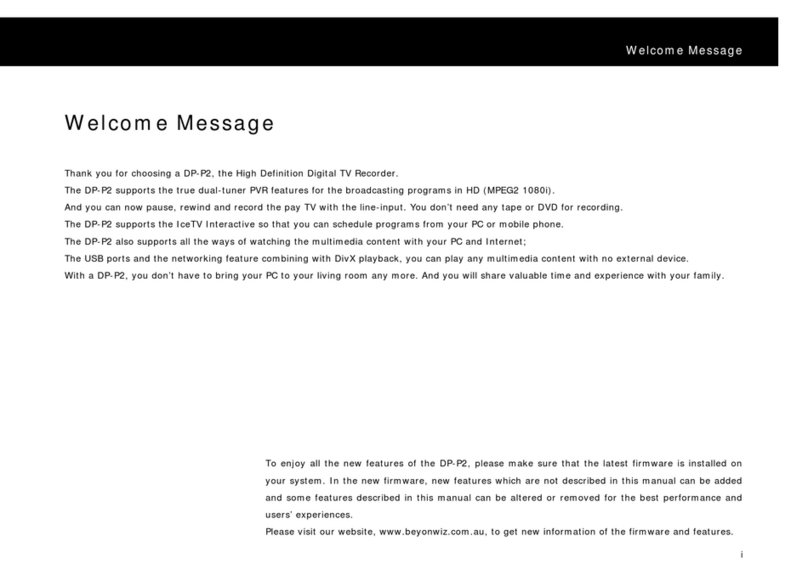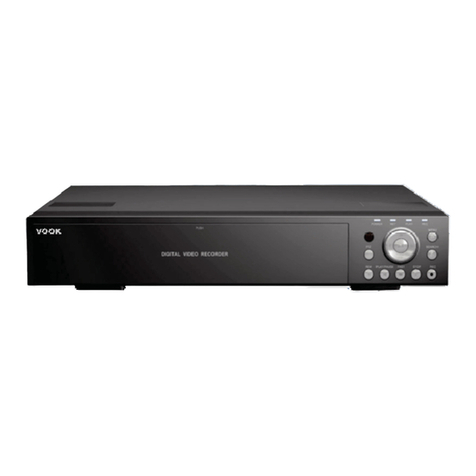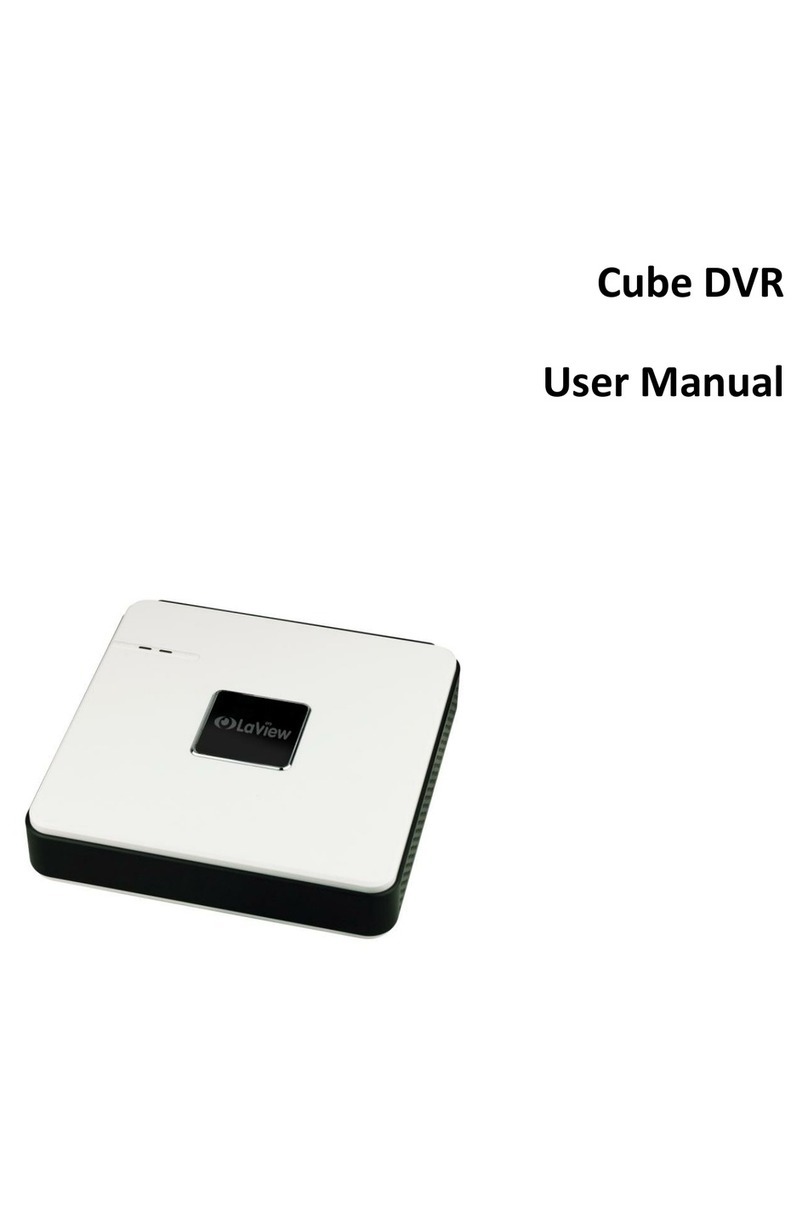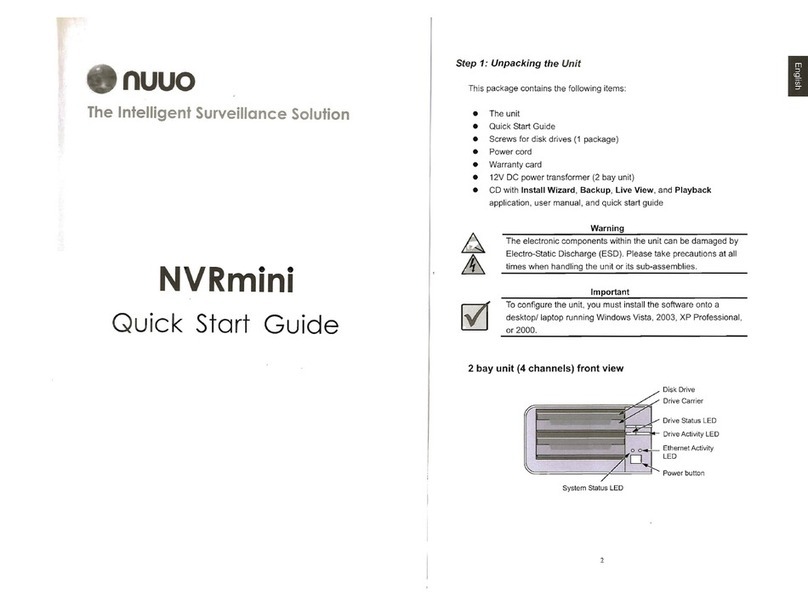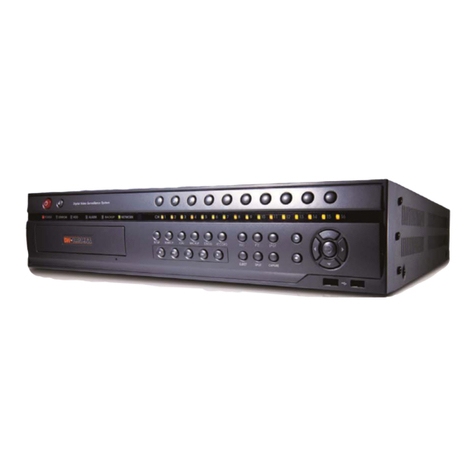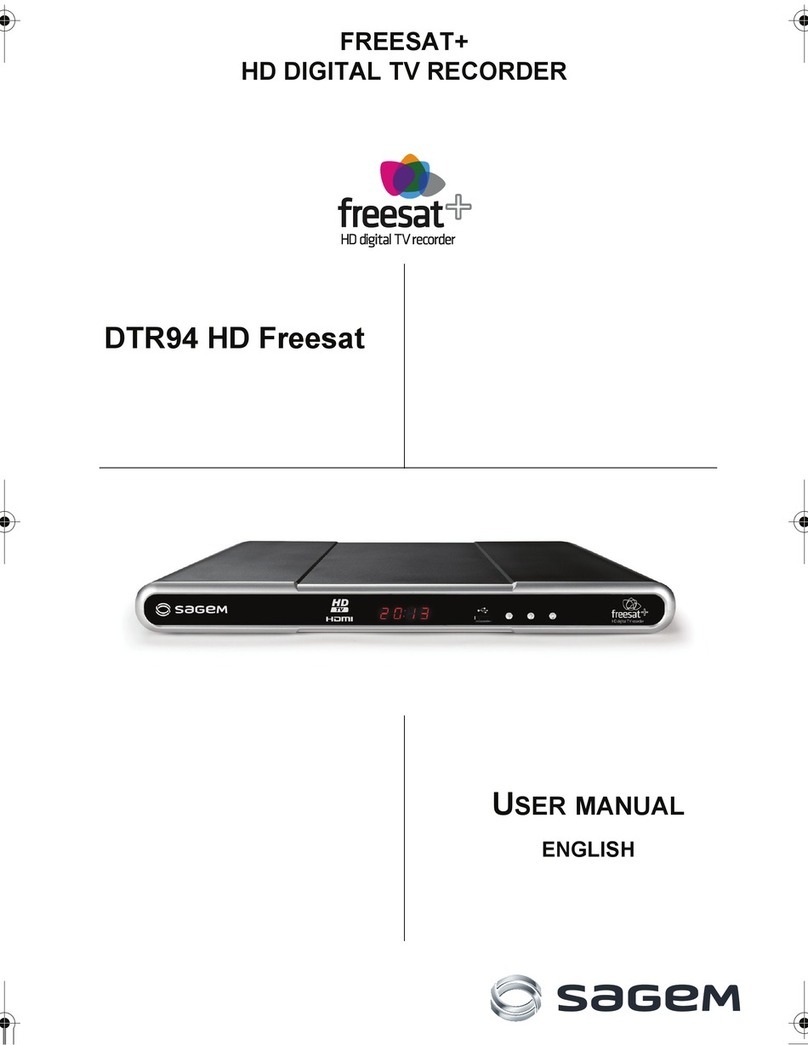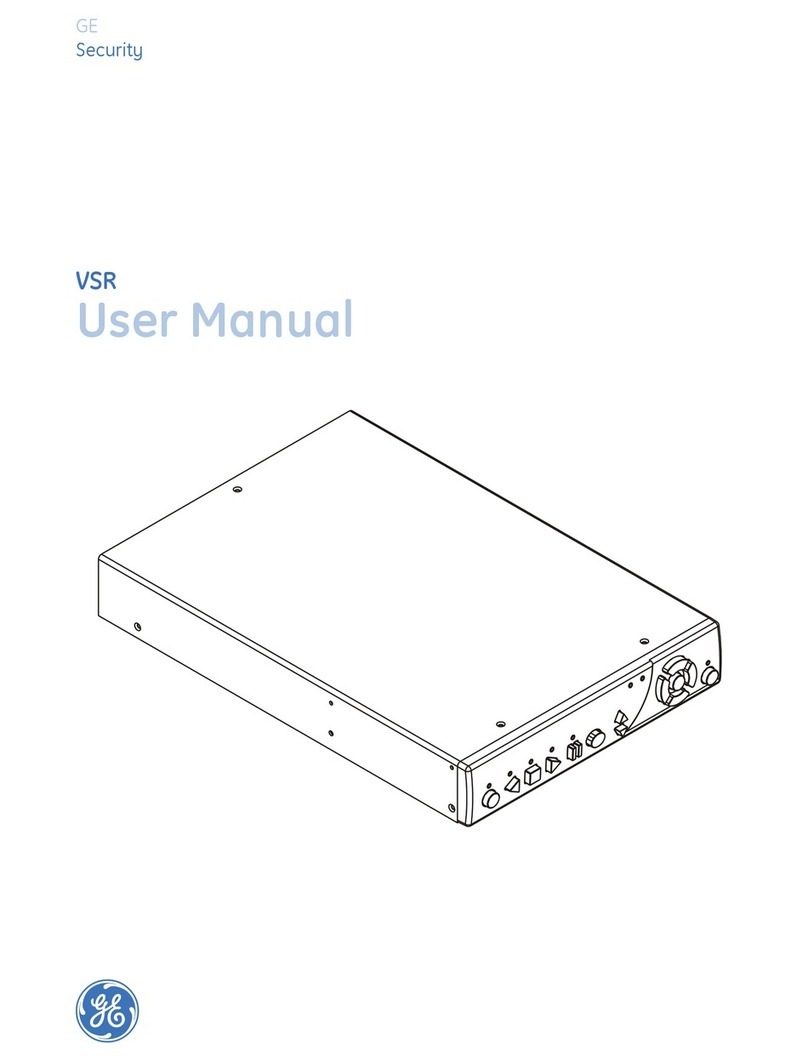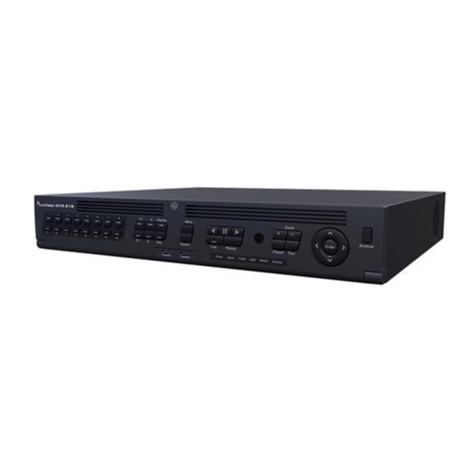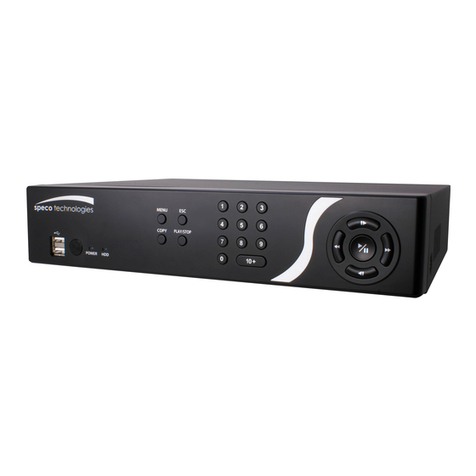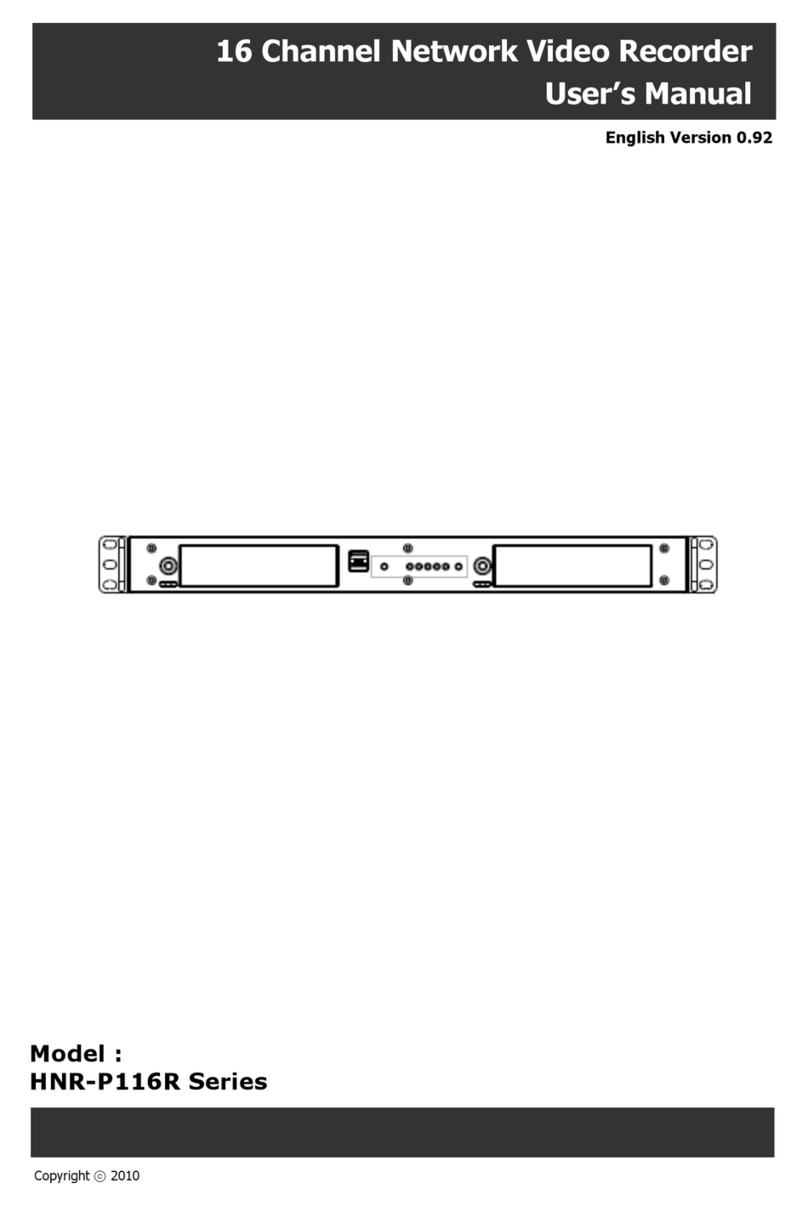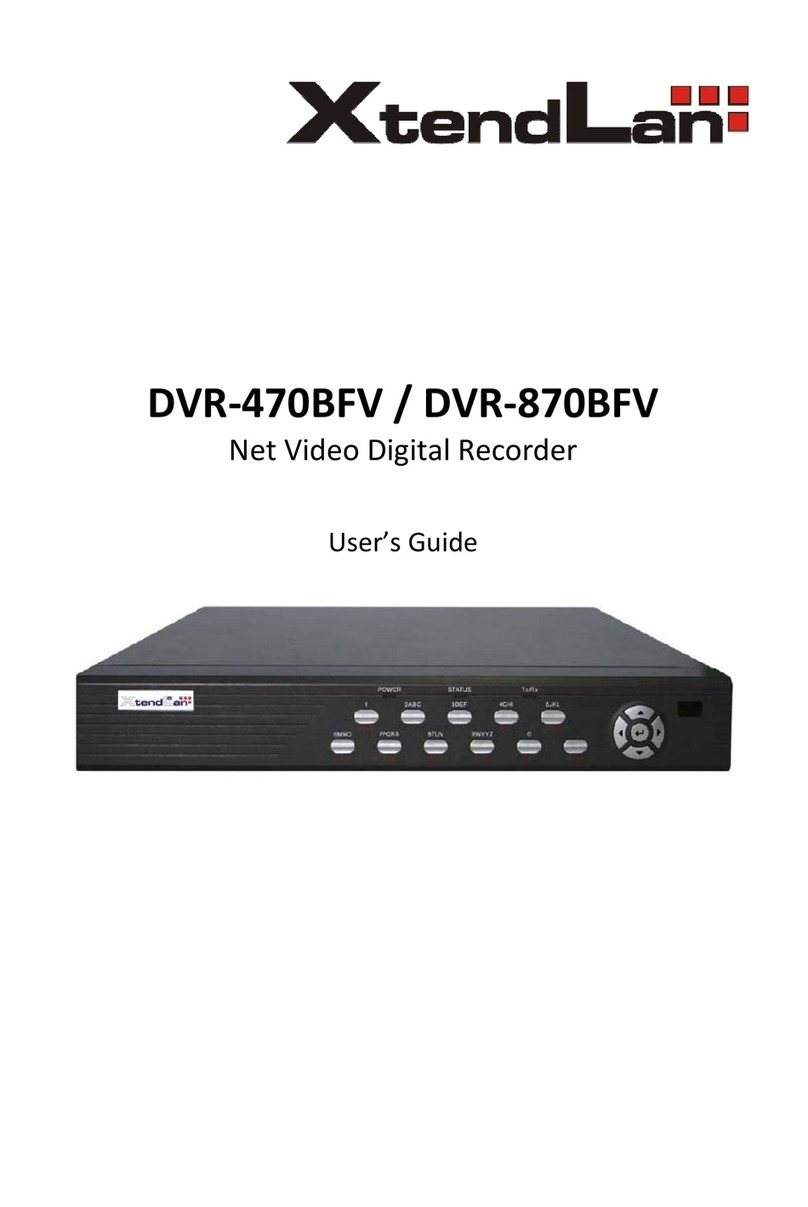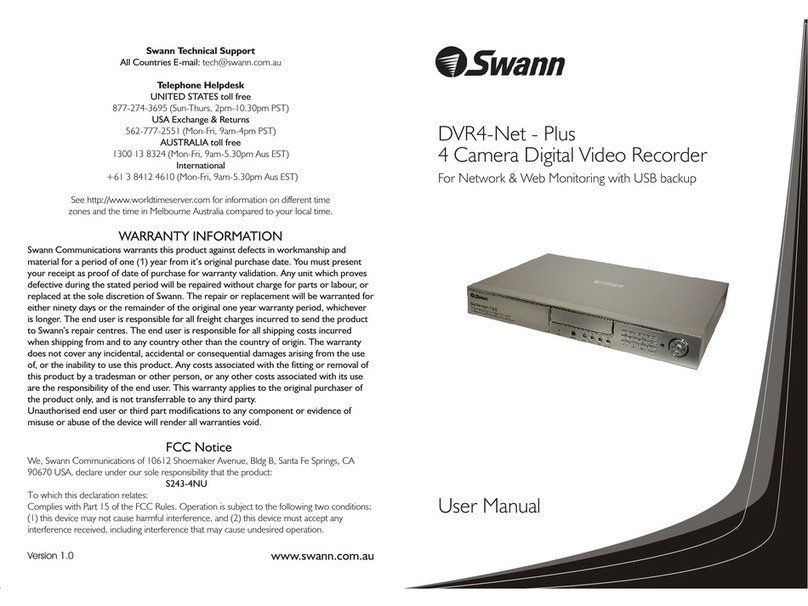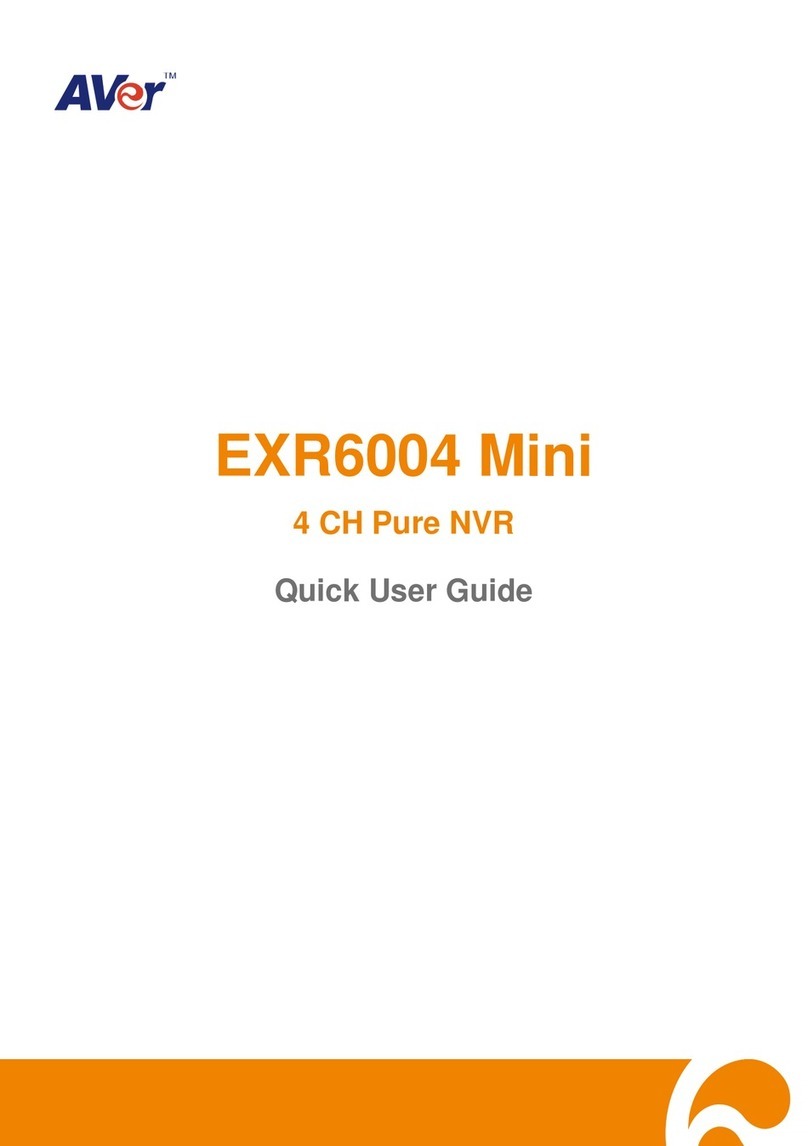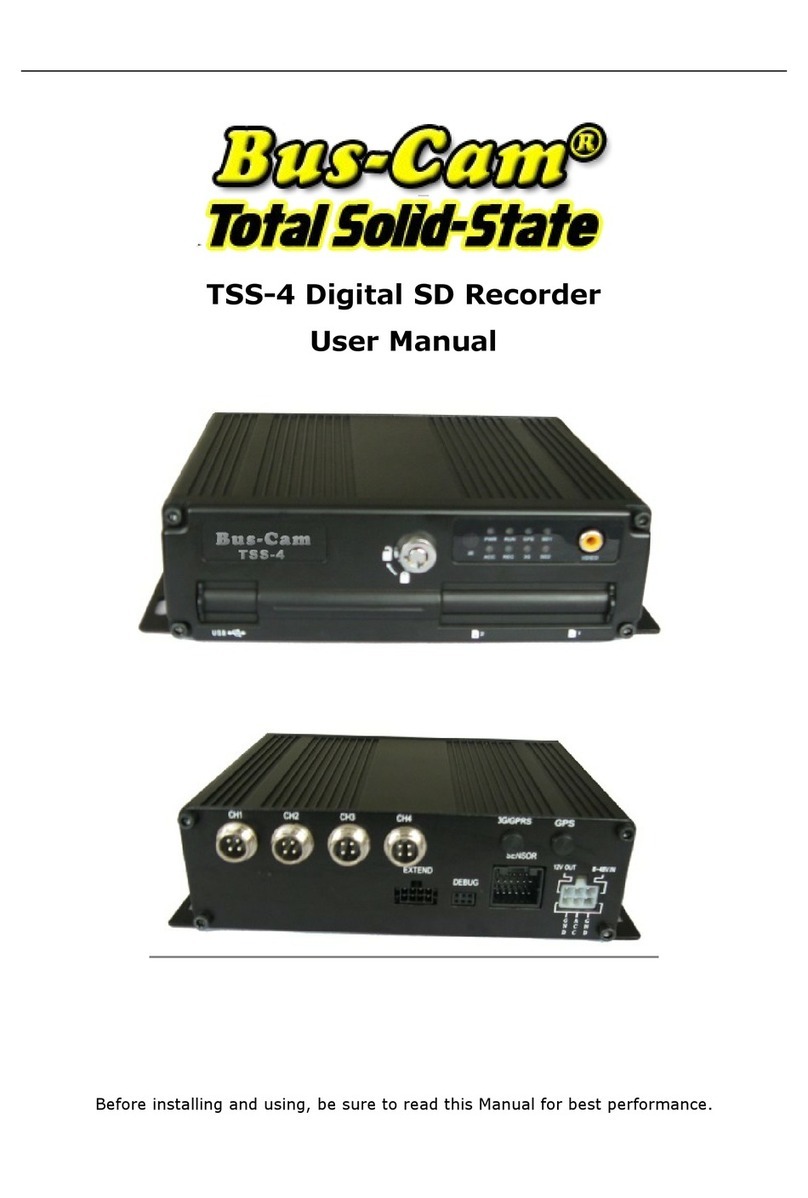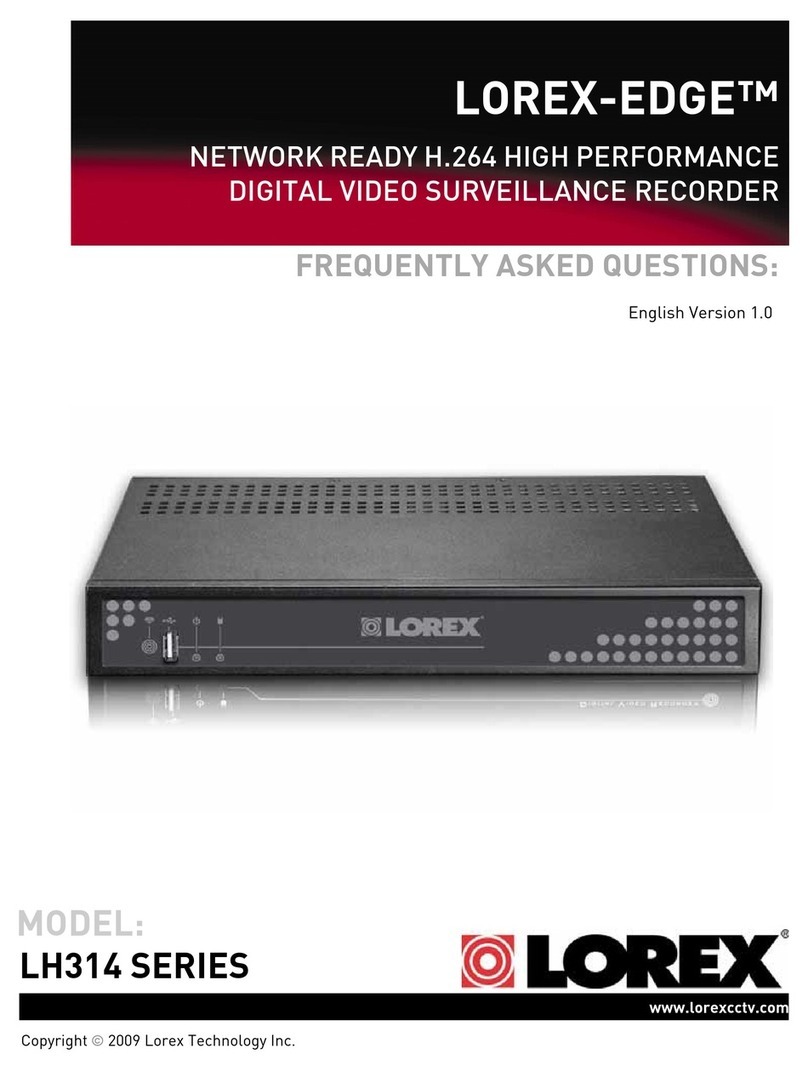Inaxsys Standalone DVR User manual

Standalone DVR Quick Start Guide
Version 1.0.0

i
Table of Contents
1Hardware Installation and Connection.......................................................................1
1.1 Check Unpacked DVR ......................................................................................1
1.2 About Front Panel and Rear Panel..................................................................1
1.3 After Remove the Chassis................................................................................1
1.4 HDD Installation.................................................................................................1
1.4.1 HDD Calculation................................................................................1
1.4.2 HDD Installation ................................................................................2
1.5 Rack Installation ................................................................................................4
1.6 Front Panel.........................................................................................................4
1.7 Rear Panel .........................................................................................................4
1.8 Connection Sample ...........................................................................................5
1.9 Alarm Input and Output Connection ................................................................6
1.9.1 Alarm Input and Output Details.........................................................7
1.9.2 Alarm Input Port ................................................................................7
1.9.3 Alarm Output Port..............................................................................8
2Overview of Navigation and Controls ........................................................................9
2.1 Boot up & Shut Down........................................................................................9
2.1.1 Boot up..............................................................................................9
2.1.2 Shut Down.........................................................................................9
2.1.3 Auto Resume after Power Failure ...................................................10
2.1.4 Replace Button Battery ...................................................................10
2.2 Change Password ........................................................................................... 10
2.3 Startup Wizard ................................................................................................. 11
2.4 Preview............................................................................................................. 13
2.5 Realtime Playback (Instant Playback)........................................................... 13
2.6 Manual Record................................................................................................. 14

ii
2.7 Search & Playback ..........................................................................................15
2.8 Schedule...........................................................................................................16
2.9 Network............................................................................................................. 17
2.10 PTZ................................................................................................................ 18
2.10.1 PTZ Setup.......................................................................................18
2.10.2 PTZ Operation.................................................................................19
2.10.3 Coaxial Control................................................................................20
2.11 Channel Type ............................................................................................... 21
2.12 Remote Device............................................................................................. 23
3Web Operation...........................................................................................................25
3.1 Network Connection........................................................................................ 25
3.2 Login ................................................................................................................. 25
3.3 Main Window.................................................................................................... 25
3.3.1 LAN Login .......................................................................................25
3.3.2 WAN Login......................................................................................26

iii
Welcome
Thank you for purchasing our DVR!
This quick start guide will help you become familiar with our DVR in a very short time.
Before installation and operation, please read the following safeguard and warning carefully!
Important Safeguard and Warning
1.Electrical safety
All installation and operation here should conform to your local electrical safety codes.
The product must be grounded to reduce the risk of electric shock.
We assume no liability or responsibility for all the fires or electrical shock caused by improper
handling or installation.
2.Transportation security
Heavy stress, violent vibration or water splash are not allowed during transportation, storage and
installation.
3.Installation
Keep upwards. Handle with care.
Do not apply power to the DVR before completing installation.
Do not place objects on the DVR.
4.Qualified engineers needed
All the examination and repair work should be done by the qualified service engineers.
We are not liable for any problems caused by unauthorized modifications or attempted repair.
5.Environment
The DVR should be installed in a cool, dry place away from direct sunlight, inflammable,
explosive substances and etc.
6. Accessories
Be sure to use all the accessories recommended by manufacturer.
Before installation, please open the package and check all the components are included:
Contact your local retailer ASAP if something is missing in your package.
7. Lithium battery
Improper battery use may result in fire, explosion, or personal injury!
When replace the battery, please make sure you are using the same model!
Caution
FOR YOUR DEVICE SAFETY, PLEASE CHANGE SYSTEM DEFAULT PASSWORD AFTER
YOU FIRST LOGIN IN!

1
1Hardware Installation and Connection
Note: All the installation and operations here should conform to your local
electric safety rules.
1.1 Check Unpacked DVR
When you receive the DVR from the forwarding agent, please check whether there is any visible
damage. The protective materials used for the package of the DVR can protect most accidental
clashes during transportation. Then you can open the box to check the accessories.
Please check the items in accordance with the list. (Remote control is optional). Finally you can
remove the protective film of the DVR.
Note
Remote control is not a standard accessory and it is not included in the accessory bag.
1.2 About Front Panel and Rear Panel
For detailed information of the function keys in the front panel and the ports in the rear panel,
please refer to the User’s Manual included in the resource CD.
The model label in the front panel is very important; please check according to your purchase
order.
The label in the rear panel is very important too. Usually we need you to represent the serial
number when we provide the service after sales.
1.3 After Remove the Chassis
Please check the data cable, power cable, COM cable and main boar cable connection is secure
or not.
1.4 HDD Installation
1.4.1 HDD Calculation
Calculate total capacity needed by each DVR according to video recording (video recording type
and video file storage time).
Step 1: According to Formula (1) to calculate storage capacity
i
q
that is the capacity of each
channel needed for each hour, unit Mbyte.
102436008 ii dq
(1)
In the formula:
i
d
means the bit rate, unit Kbit/s
Step 2: After video time requirement is confirmed, according to Formula (2) to calculate the
storage capacity
i
m
, which is storage of each channel needed unit Mbyte.
i
m
=
i
q
×
i
h
×
i
D
(2)
In the formula:
i
h
means the recording time for each day (hour)

2
i
D
means number of days for which the video shall be kept
Step 3: According to Formula (3) to calculate total capacity (accumulation)
T
q
that is needed for
all channels in the DVR during scheduled video recording.
c
iiT mq 1
(3)
In the formula:
c
means total number of channels in one DVR
Step 4: According to Formula (4) to calculate total capacity (accumulation)
T
q
that is needed for
all channels in DVR during alarm video recording (including motion detection).
c
iiT mq 1
×a% (4)
In the formula:a% means alarm occurrence rate
You can refer to the following sheet for the file size in one hour per channel. (All the data listed
below are for reference only.)
Bit stream
size(max)
File size
Bit stream size
(max)
File size
96K
42M
128K
56M
160K
70M
192K
84M
224K
98M
256K
112M
320K
140M
384K
168M
448K
196M
512K
225M
640K
281M
768K
337M
896K
393M
1024K
450M
1280K
562M
1536K
675M
1792K
787M
2048K
900M
3072Kbps
1350M
4096K
1800M
6144Kbps
2700M
8192Kbps
3600M
Note
All information listed in the above sheet for reference only. We are not reliable for any
damage or loss resulting from it.
For the space marked by the HDD manufacturer, 1K=1000, while for the computer OS,
1K=1024. So, the space recognized by the computer system is less than the marked space
on the HDD. Please pay attention to it.
All HDD space marked by the HDD manufacturer is shown as below: 1T=1000G, 1G=1000M,
1M=1000K, 1K=1000.
All HDD space marked by the HDD manufacturer shall become the computer OS space after
the corresponding calculation. For example:
1T(marked by the HDD manufacturer)=1000G/(1.024*1.024*1.024)=931G(OS space),
500G=500G/(1.024*1.024*1.024)=465G
1.4.2 HDD Installation
Important

3
Shut down the device and unplug the power cable before you install the HDD.
Always use the HDD for the surveillance product recommended by the manufacture.
All figurers listed below for reference only. Slight difference may be found on the
front or rear panel.
Please note the following contents are based on our 2U/3U series product. For
detailed operation instruction of other series products, please refer to the User’s
Manual included in the resources CD.
You can refer to the User’s Manual for recommended HDD brand. Please follow the instructions
below to install hard disk. This series DVR max supports 8 SATA HDDs. Please use HDD of
7200rpm or higher.
1.4.2.1 2U Series
①Loosen the screws of the upper cover and remove
the cover.
②Fix the HDD on the bracket. If you want to install the HDD
on the bottom bracket, you need to remove the top bracket
first.
③Connect one end of the HDD data cable to one
HDD.
④Connect the other end of the HDD data cable to the
mainboard.
⑤Connect the power cable to the HDD.
⑥Put the cover back and then fix.
1.4.2.2 3U Series

4
①Remove the HDD box from the device.
②Put the HDD to the box and then use the screws to
secure.
③Insert the HDD box to the device. Please make sure
the HDD box handle is up in case it collides with the front
panel.
④After you inserted the HDD box, put the handle back.
Important
You can connect the HDD data cable and the power cable first and then fix the HDD in the
device.
Please pay attention to the front cover. It adopts the vertical sliding design. You need to
push the clip first and then put down.
1.5 Rack Installation
Please note this installation mode is for 1.5U/2U series product.
Please follow the steps listed below.
Use twelve screws to fix the unit
Please make sure the indoor temperature is below 35℃(95°f).
Please make sure there is 15cm (6 inches) space around the device to guarantee sound
ventilation.
Please install from the bottom to the top.
If there are more accessories connected in the rack, please take precaution measures in
case the rack power is overload.
1.6 Front Panel
For detailed operation instruction, please refer to the User’s Manual included in the
resources CD.
1.7 Rear Panel

5
Please note the following contents are based on our 2U series product. For detailed
operation instruction of other series products, please refer to the User’s Manual included
in the resources CD.
This series DVR rear panel is shown as below. See Figure 1-1.
Figure 1-1
Please refer to the following sheet for detailed information.
1. Video output
2. Audio output
3. Bidirectional talk
output
4. Bidirectional talk
input
5. Audio input
6. Alarm input/alarm
output
7. Video VGA output
8. RS-232 port
9. Power socket
10. Power switch
11. GND
12. HDMI port
13. USB port
14. eSATA port
15. Network port
16. Video input
Important
When connect the Ethernet port, please use crossover cable to connect the PC and use the
straight cable to connect to the switch or router.
1.8 Connection Sample
Please note the following contents are based on our 2U series product. For detailed
operation instruction of other series products, please refer to the User’s Manual included
in the resources CD.
Please refer to Figure 1-2 for connection sample.
The following figure is based on the 16-channel series product.

6
Figure 1-2
1.9 Alarm Input and Output Connection
Please read the followings before connecting.
1. Alarm input
a. Please make sure alarm input mode is grounding alarm input.
b. Grounding signal is needed for alarm input.
c. Alarm input needs the low level voltage signal.
d. Alarm input mode can be either NC (normal Open) or NO (Normal Close)
e. When you are connecting two DVRs or you are connecting one DVR and one other device,
please use a relay to separate them,
2. Alarm output
The alarm output port should not be connected to high power load directly (It shall be less than
1A) to avoid high current which may result in relay damage. Please use the co contactor to
realize the connection between the alarm output port and the load.
3. How to connect PTZ decoder
a. Ensure the decoder has the same grounding with DVR, otherwise you may not control the PTZ.
Shielded twisted wire is recommended and the shielded layer is used to connect to the grounding.

7
b. Avoid high voltage. Ensure proper wiring and some thunder protection measures.
c. For too long signal wires, 120Ω should be parallel connected between A, B lines on the far end
to reduce reflection and guarantee the signal quality.
d. “485 A, B” of DVR cannot parallel connect with “485 port” of other device.
e. The voltage between of A,B lines of the decoder should be less than 5v.
4. Please make sure the front-end device has soundly earthed.
Improper grounding may result in chip damage.
1.9.1 Alarm Input and Output Details
You can refer to the following sheet Xfor alarm input and output information.
Important
The general 2U series product interface is shown as in
Figure 1-3.
Figure 1-3
You can refer to the following sheet for alarm input and output information.
1,2,3,4,5,
6,7,8,9,10,
11,12,13,14,
15,16
ALARM 1 to ALARM 16. The alarm becomes active in low voltage.
NO1 C1,
NO2 C2,
NO3 C3,
NO4 C4,
NO5 C5 NC5
The first four are four groups of normal open activation output
(on/off button)
NO5 C5 NC5 is a group of NO/NC activation output (on/off button)
CTRL 12V
Control power output. The power output is off when the alarm is
canceled.
+12V
It is rated power output.
Earth cable.
485 A/B
485 communication port. They are used to control devices such as
PTZ. Please parallel connect 120TΩ between A/B cables if there are
too many PTZ decoders.
T+,T-,R+,R-
They are four-wire double duplex RS485 port
T+ T-: output wire
R+ R-: input wire
1.9.2 Alarm Input Port
Please refer to the following sheet for more information.
Normal open or Normal close type.
Please parallel connect COM end and GND end of the alarm detector (Provide external
power to the alarm detector).
Use the controllable +12V power to reset the smoke sensor remotely.
AB cable
connection

8
Please parallel connect the Ground of the DVR and the ground of the alarm detector.
Please connect the NC port of the alarm sensor to the DVR alarm input(ALARM)
Use the same ground with that of DVR if you use external power to the alarm device.
Figure 1-4
1.9.3 Alarm Output Port
Provide external power to external alarm device.
For controllable +12V, it can be used to provide power to devices such as reset smoke
sensor.
To avoid overloading, please read relay parameters sheet in the User’s Manual carefully.
RS485 A/B cable is for the A/B cable of the PTZ decoder.
Relay Specification
Model:
JRC-27F
Material of the
touch
Silver
Rating
(Resistance
Load)
Rated switch capacity
30VDC 2A, 125VAC 1A
Maximum switch power
125VA 160W
Maximum switch voltage
250VAC, 220VDC
Maximum switch currency
1A
Insulation
Between touches with same
polarity
1000VAC 1minute
Between touches with different
polarity
1000VAC 1minute
Between touch and winding
1000VAC 1minute
Surge voltage
Between touches with same
polarity
1500V (10×160us)
Length of open
time
3ms max
Length of close
time
3ms max
Longevity
Mechanical
50×106 times (3Hz)
Electrical
200×103 times (0.5Hz)
Temperature
-40℃~+70℃

9
2Overview of Navigation and Controls
Please note the following figures for reference only. For detailed operation instruction,
please refer to the User’s Manual included in the resources CD.
Before operation, please make sure:
You have properly installed HDD and all the cable connections.
The provided input power and the device power are matched.
Always use the stable current, if necessary UPS is a best alternative measure.
2.1 Boot up & Shut Down
2.1.1 Boot up
Please follow the steps listed below to boot up the device.
Connect the device to the monitor and then connect a mouse.
Connect power cable.
Click the power button at the front or rear panel and then boot up the device. After device
booted up, the system is in multiple-channel display mode by default.
2.1.2 Shut Down
Note
When you see corresponding dialogue box “System is shutting down…” Do not click power
on-off button directly.
Do not unplug the power cable or click power on-off button to shutdown device directly when
device is running (especially when it is recording.)
There are three ways for you to log out.
Main menu (RECOMMENDED): From Main Menu->Operation->Shutdown, click shutdown
button, you can see device shuts down. See Figure 2-1.
Figure 2-1
From power on-off button on the front panel or remote control. Press the power on-off button
on the DVR front panel or remote control for more than 3 seconds to shutdown the device.
From power on-off button on the rear panel.

10
2.1.3 Auto Resume after Power Failure
The system can automatically backup video and resume previous working status after power
failure.
2.1.4 Replace Button Battery
Please make sure to use the same battery model if possible.
We recommend replace battery regularly (such as one-year) to guarantee system time
accuracy.
Important
Before replacement, please save the system setup, otherwise, you may lose the data
completely!
2.2 Change Password
For you own safety, please change your administrator default password after your first
login.
After system booted up, you can see the following interface if it is your first login or you have
restored default setup. The default administrator user name is admin and the password is admin.
See Figure 2-2.
Please input old password and then input new password twice to confirm the change.
Figure 2-2
Click Cancel button, system pops up the following interface for you to confirm. See Figure 2-3.
Check the box here, system will not pop up the change password interface the next time.

11
Figure 2-3
2.3 Startup Wizard
After changed admin password interface, system goes to the startup wizard interface. See Figure
2-4 (General series) and Figure 2-5 (Hybrid series).
Please refer to the user’s manual for detailed startup wizard operation information.
Tips
Check the box Startup button here, system goes to startup wizard again when it boots up the
next time.
Cancel the Startup button, system goes to the login interface directly when it boots up the next
time.
Figure 2-4

12
Figure 2-5
The system login interface is shown as in Figure 2-6.
System consists of four accounts:
Username: admin. Password: admin. (administrator, local and network)
Username: 888888. Password: 888888. (administrator, local only)
Username: 666666. Password: 666666(Lower authority user who can only monitor, playback,
backup and etc.)
Username: default. Password: default(hidden user)
You can use USB mouse, front panel, remote control (not included in the accessory bag) or
keyboard to input. About input method: Click to switch between numeral, English
character (small/capitalized) and denotation.
Important
For security reason, please change factory default password after you first login.
Continuous three times login failure will result in system alarm and five times login failure will
result in account lock!
Please reboot the device or wait for 30 minutes if your account has been locked.
Figure 2-6

13
2.4 Preview
After you logged in, the system is in live viewing mode by default. You can see system date, time
and channel name. See Figure 2-7. If you want to change system date and time, you can refer
to general settings (Main Menu->Setting->System->General). If you want to modify the channel
name, please refer to the channel name settings (Main Menu->Setting->Camera->CAM Name)
At the right corner of the each window, you can see there is a window serial number. Once the
channel sequence is random or you have changed the channel name, you can use this window
number to confirm current channel name so that you can search the record or playback.
Figure 2-7
Tips
Preview drag: If you want to change position of channel 1 and channel 4 when you are
previewing, you can left click mouse in the channel 1 and then drag to channel 4,
release mouse you can switch channel 1 and channel 4 positions.
2.5 Realtime Playback (Instant Playback)
Move you mouse to the top centre of the video of current channel, you can see system pops
up the preview control interface. See Figure 2-8 (The image at the top left). If your mouse
stays in this area for more than 6 seconds and has no operation, the control bar
automatically hides.
1
When current channel is
recording, system
displays this icon.
3
When video loss alarm occurs,
system displays this icon.
2
When motion detection
alarm occurs, system
displays this icon.
4
When current channel is in monitor
lock status, system displays this
icon.

14
Figure 2-8
Click , you can go to the realtime playback interface. It is to playback the previous 5-60
minutes record of current channel.
Please go to the Main Menu->Setting->System->General to set real-time playback time.
System may pop up a dialogue box if there is no such record in current channel.
2.6 Manual Record
Note:
You need to have proper rights to implement the following operations. Please make sure the
HDD has been properly installed.
There are three ways for you to go to manual record menu.
Right click mouse and then select Manual->Record.
In the main menu, from Storage->Record.
In live viewing mode, click record button in the front panel or record button in the remote
control.
Manual record menu is shown as in Figure 2-9.
System supports main stream and sub stream. There are three statuses:
schedule/manual/stop. Please highlight icon“○” to select corresponding channel.
Manual: The highest priority. After manual setup, all selected channels will begin ordinary
recording.
Schedule: Channel records as you have set in recording setup (Main Menu->Setting-
>System->>Schedule)
Stop: Current channel stops recording.
All: Check All button after the corresponding status to enable/disable all-channel
schedule/manual record or enable/disable all channels to stop record.

15
Figure 2-9
2.7 Search & Playback
Click search button in the main menu, or right click mouse and then select Search button when
you are previewing, search interface is shown as below. See Figure 2-10.
Usually there are three file types:
R: Regular recording file.
A: External alarm recording file.
M: Motion detection recording file.

16
Figure 2-10
Please refer to the following sheet for more information.
SN
Name
SN
Name
1
Display pane
2
Search engines
3
Calendar
4
Playback mode and channel
5
Card search button
6
Mark file list button
7
File list switch
8
Playback control
9
Time bar
10
Time bar unit
11
Backup
12
Clip button
13
Record type
2.8 Schedule
Note:
You need to have proper rights to implement the following operations. Please make sure the
HDDs have been properly installed.
After the system booted up, it is in default 24-hour regular mode. You can set record type and
time in schedule interface.
In the main menu, from Setting->Storage->Schedule, you can go to schedule menu. See
Figure 2-11.
Table of contents
Other Inaxsys DVR manuals

